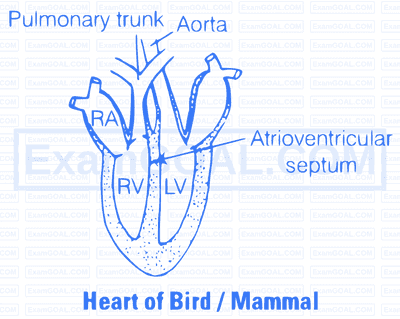Briefly describe the followings
(a) anaemia
(b) angina pectoris
(c) atherosclerosis
(d) hypertension
(e) heart failure
(f) erythroblastosis foetalis
(a) Anaemia is the decrease in the number of RBC than the normal amount and also due to less quantity of haemoglobin than the normal value in blood This is the most common disorder of the blood.
(b) Angina Pectoris Ocurs when there is blockage in coronary artery, thus in sufficient supply of blood reaches to heart muscles. This results in chest pain, fear, anxiety, pale skin, profuse sweating and vomitting. The anginal pain usually starts in the centre of the chest spreads down to the left arm which last for only few second.
(c) Atherosclerosis is the deposition of cholesterol in the inner lining of arteries called atherosclerotic plaque. Sometimes arteries are completely blocked, this result in stroke or heart attack.
(d) Hypertension Ps sometimes also called as arterial hypertension. The blood pressure in the arteries getselevated. It could be primary hypertension which has no obvious medical reason but secondary hypertension are caused by various conditions which affect kidneys, arteries heart or endocrine system.
(e) Heart Failure is the state of heart when it does not pump blood effectively enough to meet the needs of the body.
(f) Erythroblastosis foetalis is a haemolytic disease of new borns which is an allo-immune condition that develops in foetus when IgG molecules produced by mother pass through placenta and attack RBC causing reticulocytosis and anaemia. It develops due to Rh incompatibility between the couples. In a man with $\mathrm{RH}^{+}$blood and women with $\mathrm{Rh}^{-}$, blood the second pregnancy foetus may have this problem due to IgG accumulation in women during first child development and delivery.
The birds and mammals have evolutionary advancement as far as structure of heart is concerned. They need more oxygen to live in terrestrial habitat.
In these animals, the blood received by left and right auricles is oxygenated and deoxygenated respectively. It passes towards the left and right ventricles and thus no oxygenated and deoxygenated blood is mixed. The ventricles pump oxygenated deoxygenated blood without mixing.
Thus, two separate circulatory pathways are found thus this type of blood circulation is called as double circulation, which include systemic and pulmonary circulation.

Hepatic Portal System
There is special vascular connection that exists between the digestive tract and liver in all chordates and is called as hepatic portal system. This system carries blood from intestine to the liver before it is delivered to the systemic circulation.
Significance of hepatic portal system in circulatory system
(i) Blood that comes from alimentary canal contain glucose, amino acids and other nutrients. The liver absorbs excess of fats and glucose to be used at the time of starvation when blood passess through given.
(ii) Harmful nitrogenous wastes like ammonia is converted into urea which is later removed by kidney.
(iii) Liver produces proteins which are transported through blood circulation (e.g., fibrinogen for blood clotting).
Human Lymphatic System comprises of lymph, lymphatic capillaries, lymphatic vessels, lymphatic ducts and lymphatic nodes.
Functional significance of lymphatic system
(i) It removes $\mathrm{CO}_2$ and other metabolic waste from the tissue where blood vessels can not reach.
(ii) Lymphatic blood capillaries of intestine are called lacteals, which help in absorption of fats.
(iii) Lymph filters through out lymph nodes where phagocytotic WBC and macrophages are present in a good number which eats harmful microorganisms and remove foreign particles from the body fluid.
Write the features that distinguish between the two
(a) plasma and serum
(b) open and closed circulatory system
(c) sino-atrial node and atrio-ventricular node
(a) Difference between plasma and serum are as follows
| Blood Plasma | Blood Serum |
|---|---|
| It is the fluid without blood corpuscles. | It is liquid without dotting elements. |
| It is faint yellow in colour. | It is pale yellow. |
| It has fibrinogen and other clotting materials. | It does not have fibrinogen and other clotting materials. |
| It takes part in blood clotting. | It does not take part in blood clotting. |
(b) Difference between open and closed circulatory system are as follows
| Open Circulatory System | Closed Circulatory System |
|---|---|
| Open circulation occurs in arthropods and molluscs. | It occurs in annelids (earthworms), some molluscs and all vertebrates. |
| The blood is not completely enclosed within vessels, the heart pumps blood through arteries into large cavities or sinuses, where it mixes with the interstitial fluid and bathes the cells of the body. | In closed circulatory system, materials move between the blood and interstitial fluid through thin walls capillaries. |
| Circulation is slower in an open system, because some of the blood pooled in sinuses and, the heart is unable to build up enough pressure to make the blood flow rapidly. | Blood flows at a high pressure in a closed circulatory system. |
| Respiratory pigment, if present, is dissolved in the plasma, no red corpuscles are present. | Respiratory pigment is present which may be dissolved in the plasma but is usually contained red blood corpuscles. |
(c) Difference between sino atriol node and artrio-ventricular node are as follow
| SA Node | AV Node |
|---|---|
| It is the small mass of specialised muscle cells in the wall of right atrium near the opening of vena cava. | It is situated in the fibrous ring between the right atrium and ventricle of the heart. |
| It initiates and maintains the heart beat. | It is the pathway through, which electrical impulses can pass.s. |